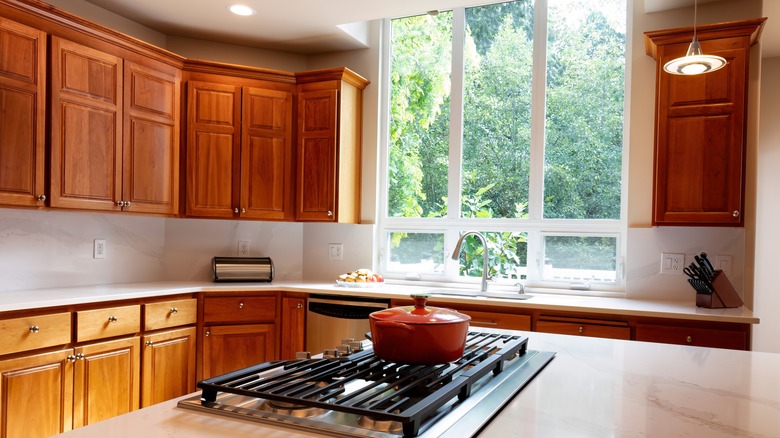The DIY Mistake To Avoid While Redoing Your Kitchen Cabinets
You've made the commitment to refinish your own kitchen cabinets. You remove the doors, sand the wood, apply the stain, and wipe away the excess. Then, over the next several hours, you watch in horror as your gorgeous cabinet makeover turns into a blotchy, patchy DIY nightmare of epic proportions. Where did it all go wrong? What could you have done to prevent such a monstrosity from taking the place of your gorgeous new cabinet aesthetic reveal?
Unfortunately, blotchy kitchen cabinet stain happens. Luckily, there are usually steps you can take to prevent the phenomenon from striking your beloved kitchen makeover. From the type of wood your cabinets are constructed out of to the way you prepare them for taking stain, there are a whole host of factors to consider before attempting to stain your cabinets. These are the steps to take when taking the fate of your kitchen into your own hands.
Mistakes that cause blotchy stain
When your newly stained cabinets look splotchy, blotchy, or patchy, it means that the wood did not evenly absorb the stain that was applied. There are several common staining mistakes that can lead to uneven absorption. The first is simply choosing the wrong type of wood. If your cabinets are made from softwood like pine or cedar, they are likely to absorb stain unevenly. These woods are more suitable for painting than staining. Hardwoods like oak, in comparison, tend to stain quite evenly. If your hardwood cabinets absorb stain unevenly, it is likely due to improper preparation or application. Before staining, your cabinets should be thoroughly sanded to remove nooks and crannies where excess stain can hide.
Next, the wood should be treated with a pre-stain conditioner. Conditioning the wood allows it to absorb the conditioner solution first, increasing the chances that the stain will be absorbed evenly when applied. Once the wood has been conditioned, it's important to apply your stain using long strokes that cover the surface end-to-end, if possible. Staining small sections makes you more likely to create overlap lines. Finally, excess stain should be wiped away after the specified stain time. Otherwise, darker splotches will form where the excess stain has dried.
What to do if your stain looks blotchy
If your stained cabinets end up looking blotchy, it's okay to be disappointed. If possible, take a day or two to regroup before you head back to the kitchen to remedy the situation. If your cabinets are made of softwood, your best option is to paint over the stain using a paint that is specifically designed for cabinets. These paints provide a harder, more durable finish that will make your cabinets more resistant to everyday wear.
For blotchy stained hardwood cabinets, your easiest options are to paint over the stain with cabinet paint or try staining the wood again with a darker stain. While it may be difficult to change the image you had in your mind, you can still achieve your desired aesthetic. If you had chosen a warm stain shade like honey, look for a paint or darker stain that is also warm-toned, like chestnut. If you had your heart set on a light cool-toned stain, swap it for a darker one like espresso. As long as the tone is the same, all the décor you have planned should still work beautifully in the space.

